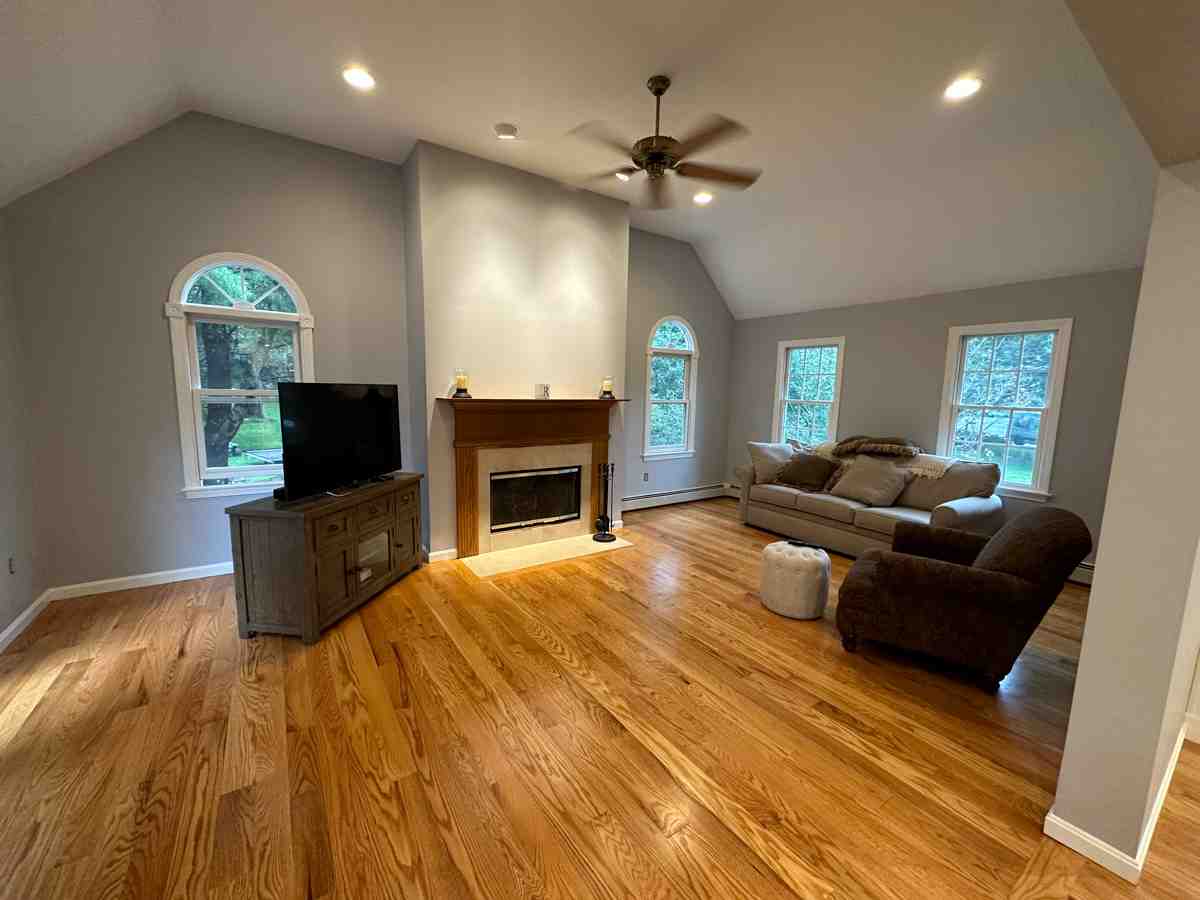Adding Windows to a House: 5 Powerful Benefits in 2024
Adding windows to a house can transform your living space, making it brighter, more inviting, and energy-efficient. If you’re considering this upgrade, here’s a quick overview to get you started:
- Find out local Building Code requirements.
- Locate the best spot for the new window.
- Choose the type of window suited to your needs.
- Check for any wiring, plumbing, or ductwork in the chosen area.
With these basics covered, rest assured you’re on the right path toward a successful window addition.
Natural light has a magical way of changing a room’s atmosphere. Imagine sitting in your favorite chair, reading a book by a new, sunlit window, or cooking with a gorgeous garden view. Adding windows doesn’t just add light; it adds life to your home.
I’m Tyler Tranni, the owner of Tranni Home Remodeling. With years of experience in home renovations, I’ve helped many homeowners in Billerica, MA, brighten their homes by adding new windows efficiently and beautifully.

Adding windows to a house word list:
– basement window replacement
– bay window replacement
– vinyl window replacement
Why Add Windows to Your House?
Adding windows to your house can be a game-changer. It improves natural light, boosts energy efficiency, increases home value, and improves aesthetics. Let’s explore why this upgrade is worth considering.
Soak Up the Sun
Natural light can transform a room. It brightens up spaces, making them feel larger and more inviting. Plus, natural light can improve your mood and well-being. Imagine waking up to sunlight streaming through your bedroom window or enjoying your morning coffee in a sunlit kitchen.
More natural light also means you can cut down on electricity usage. With more daylight available, you can keep the lights off longer, saving on energy bills.
Take in the View
Windows connect you to the world outside. They improve both the interior and exterior aesthetics of your home. From the inside, well-placed windows can frame beautiful views, whether it’s a lush garden or a serene street.
On the outside, windows add character and charm to your home’s facade. They break up blank walls and create a more balanced, appealing look. Plus, having a great view can make your home feel more connected to nature, bringing a sense of peace and relaxation.
Increase Home Value
Adding windows can significantly boost your home’s value. Homes with ample natural light and attractive views tend to sell faster and at higher prices. This upgrade not only improves your daily living experience but also pays off when it’s time to sell.
Energy-efficient windows are particularly valuable. They can lower heating and cooling costs, making your home more attractive to eco-conscious buyers. And let’s not forget curb appeal—new windows can give your home a fresh, updated look that stands out in the neighborhood.
Adding windows to your house is more than just a renovation; it’s an investment in your quality of life and property value. Whether you’re soaking up the sun, taking in the view, or boosting your home’s market appeal, the benefits are clear. Ready to let the light in? Let’s move on to planning and design.
Planning and Design
Planning is key when adding windows to a house. You need to consider the location, size, type of window, and how it fits with your home’s architectural style. Let’s break it down.
Choosing the Right Location
First, decide where the window will go. Think about how it will look from both inside and outside. Inside, consider where natural light is needed most. For example, adding a window in a dark hallway can make the space feel more open and inviting.
Also, think about the view. A window in the living room looking out onto a garden can be a beautiful focal point. On the exterior, the window should complement the design of your home. It should balance with other windows and doors to create a cohesive look.
Sun exposure is another important factor. South-facing windows get the most sunlight, which is great for rooms where you want lots of natural light. But be mindful of heat gain in the summer. North-facing windows provide softer, more consistent light, which is ideal for spaces like an office or studio.
Selecting the Window Type
Next, choose the type of window. There are several options, each with its own benefits:
- Double-hung windows: These are classic and versatile. They have two sashes that move up and down, allowing for good ventilation.
- Casement windows: Hinged on the side, they open outward like a door. They provide excellent ventilation and are easy to clean.
- Awning windows: Hinged at the top, they open outward. They are great for letting in air even when it’s raining.
- Low-E windows: These have a special coating that reflects heat. They help keep your home warm in winter and cool in summer.
- Double-pane and triple-pane windows: These have two or three layers of glass with insulating gas in between. They are highly energy-efficient and reduce noise.
Choosing the right window type not only affects the look of your home but also its energy efficiency and comfort.
Permits and Regulations
Before you start, check your local building codes. Adding a window usually requires a permit. You’ll need to submit plans showing the size and location of the window, as well as how it will be installed.
Contact your local building department to find out what permits you need. You may also need to schedule inspections at different stages of the project. This ensures that the work meets safety standards and building codes.
Skipping permits can lead to fines and complications when you sell your home. It’s always best to follow the rules and get the necessary approvals.
With careful planning and design, adding windows to your house can be a smooth process. Next, let’s explore the structural considerations to ensure your new window is safe and secure.
Structural Considerations
When adding windows to a house, structural integrity is paramount. A new window opening affects the load distribution and stability of your home. Here’s what you need to know.
Consulting a Structural Engineer
Before you start cutting into walls, consult a structural engineer. They ensure safety and proper load distribution. This is crucial, especially for load-bearing walls. These walls support the weight of the house, and improper handling can compromise structural integrity.
Why consult a structural engineer?
– Safety: They assess the wall’s load-bearing capacity.
– Load Distribution: They design solutions to redistribute the load.
– Structural Support: They recommend the best practices for framing the new opening.
Safety first. An engineer’s expertise prevents costly mistakes and ensures your project complies with local building codes.
Framing the Window
Framing a window involves more than just cutting a hole. Proper framing ensures the window is secure and the wall remains strong. Here are the key components:
-
King Studs: These are full-height studs on either side of the window opening. They support the header and distribute the load to the floor.
-
Jack Studs: Also known as trimmer studs, these are shorter and support the header directly. They transfer the load from the header down to the sill plate.
-
Headers: The header is a horizontal beam above the window. It supports the load from above and transfers it to the jack studs. Depending on the window size, headers are typically made from 2×8 or 2×10 lumber.
-
Sill Plates: This is the bottom part of the window frame. It sits on the cripple studs and supports the window.
-
Cripple Studs: These are short studs below the sill plate. They transfer the load from the sill plate to the floor.
Steps to Frame a Window:
1. Measure and Mark: Accurately measure and mark the wall for the rough opening.
2. Cut the Opening: Use a circular saw to cut the drywall and remove the existing studs.
3. Install King Studs: Attach the king studs on either side of the opening.
4. Add Jack Studs: Nail the jack studs to the king studs.
5. Insert the Header: Place the header on top of the jack studs.
6. Install the Sill Plate: Attach the sill plate at the bottom of the opening.
7. Add Cripple Studs: Nail cripple studs below the sill plate.
Proper framing is essential for maintaining the structural integrity of your home. It ensures the window is secure and the load is evenly distributed.
Now that we’ve covered the structural considerations, let’s move on to the step-by-step guide for adding windows to your house.
Step-by-Step Guide to Adding Windows to a House
Measuring and Cutting the Opening
Accurate measurements and precise cuts are essential when adding windows to a house. Here’s how to start:
Preparation
- Materials: Circular saw, straight-edge ruler, razor knife, tape measure, level.
- Tools: Safety gear, hammer, nails, screws, shims.
Steps:
- Measure and Mark:
- From inside, measure from the floor and ceiling. Mark the dimensions on the wall.
-
Draw window measurements using a straight-edge ruler.
-
Cut the Drywall:
- Follow the marked lines with a circular saw.
-
Remove the drywall to expose insulation and studs.
-
Remove Insulation and Studs:
- Cut through the insulation vapor barrier with a razor knife.
-
Remove the studs within the window opening.
-
Prepare for Framing:
- Remove the top studs above the window, ensuring no damage to the surrounding drywall.
- Avoid cutting through the exterior siding and plywood until framing is complete.
Installing the Window
With the opening prepared, it’s time to install the window.
Setting the Window:
- Dry-Fit the Window:
- Slide the window into the opening to check the fit.
-
Remove it to apply caulk.
-
Apply Caulk:
- Run beads of caulk along the sill, header, and vertical sides.
-
Add extra caulk at the corners.
-
Place the Window:
- Raise both sashes and lift the window into the opening.
-
Use shims to adjust and level the window.
-
Secure the Window:
- Loosely fasten the bottom corners with screws.
- Add more screws at mid-center and upper corners.
-
Tighten screws after ensuring the window is plumb and level.
-
Insulate:
- Use putty knives to stuff insulation around the window frame.
- Avoid over-stuffing to prevent bowing.
Finishing Touches
The final steps ensure your new window looks great and performs well.
Interior Trim:
- Drywall:
- Cut and fit drywall pieces around the window.
-
Use joint compound and tape to blend seams.
-
Trim:
- Install vertical and horizontal trim to match existing styles.
- Fill nail holes with wood filler and apply a final coat of paint.
Exterior Trim:
- Flashing and Caulking:
- Apply flashing tape over the window flange.
-
Use exterior caulk around the trim to prevent leaks.
-
Painting:
- Paint the exterior trim to match your home’s siding.
- Ensure all caulk and filler are dry before painting.
Following these steps, you’ll transform blank walls into beautiful views, adding both aesthetic and functional value to your home. Next, let’s address some frequently asked questions about adding windows to a house.
Frequently Asked Questions about Adding Windows to a House
How Expensive is it to Add Windows to a House?
The cost of adding windows to a house can vary widely. Here are some factors that affect the cost:
- Type of Window: Double-pane, triple-pane, and specialty windows like bay or bow windows can be more expensive.
- Materials: Vinyl and aluminum frames are generally cheaper than wood.
- Size of the Window: Larger windows will naturally cost more.
- Structural Changes: Cutting into load-bearing walls or concrete can increase costs significantly.
Cost Range: On average, you can expect to pay between $1,000 and $5,000 per window. If you’re cutting into a wood-framed wall, the cost is usually between $150 to $250. For concrete walls, expect to pay $350 to $600.
Budgeting Tips:
– Get Multiple Quotes: This helps you find the best price.
– Opt for Standard Sizes: Custom sizes can be more expensive.
– Look for Off-Peak Discounts: Some companies offer lower rates in the winter.
Is it Difficult to Add Windows to a House?
Adding windows to a house is a complex task that requires careful planning and execution.
Skill Level: This project is generally considered advanced due to the structural changes involved.
Common Challenges:
– Structural Integrity: Cutting into walls can weaken the structure, requiring headers and supports.
– Utilities: Avoiding electrical wiring, plumbing, and ductwork can be tricky.
– Weatherproofing: Proper sealing and flashing are essential to prevent leaks.
DIY vs Professional:
– DIY: Can save you about 15% on labor costs, but mistakes can be costly.
– Professional: More expensive but ensures the job is done correctly and safely.
Can I Add a Window to My House Myself?
While it’s possible to add a window yourself, it’s not a project for the faint of heart.
DIY Considerations:
– Safety: Heavy lifting and cutting into walls can be dangerous.
– Tools Needed: Circular saw, reciprocating saw, level, shims, caulk, and more.
– Time Investment: Expect to spend at least a couple of days if you’re inexperienced.
Safety Tips:
– Wear Safety Gear: Gloves, goggles, and a dust mask.
– Check for Lead Paint: Homes built before 1978 may have lead-based paint.
For most homeowners, hiring a professional is the best route. It ensures structural integrity and saves time and potential headaches.
Next, let’s wrap up with the benefits and how Tranni Home Remodeling can help you achieve your window dreams.
Conclusion
Adding windows to your house can transform your living space in many ways. From increased natural light to improved energy efficiency and improved home value, the benefits are clear.
Summary of Benefits
- Natural Light: Brightens up your home, reducing the need for artificial lighting and boosting your mood.
- Energy Efficiency: Modern windows can help lower heating and cooling costs.
- Home Value: Adds curb appeal and increases resale value.
- Aesthetics: Improves both interior and exterior appearances, creating a more inviting atmosphere.
- Connection to Nature: Larger windows or window-pane doors can offer beautiful views and a stronger connection to the outdoors.
How Tranni Home Remodeling Can Help
At Tranni Home Remodeling, we specialize in high-quality window installation that improves the beauty, security, and energy efficiency of your home. Our skilled team is dedicated to delivering exceptional craftsmanship and outstanding service.
Why Choose Us?
- Expertise: With over a decade of experience, we know how to get the job done right.
- Quality Products: We use only the best materials from reputable manufacturers.
- Customer Focus: We prioritize your needs and ensure your satisfaction from start to finish.
- Comprehensive Services: From consultation to installation and beyond, we offer a full range of services to meet your window and door needs.
Ready to transform your home with beautiful new windows? Contact us today to get started on your project.
For more information, visit our Windows and Doors page. We look forward to helping you create a brighter, more energy-efficient, and beautiful home.





